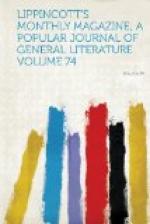One asked if we should go to heaven in the cars. I said I had been told that we should go through the air, perhaps fly there. A little girl immediately held up a wood-cut of a vulture, saying, “Ugly thing! I don’t want to be one.” A boy whose new skates lay spoiling for the ice in his trunk asked if he could skate there. Not having quite the faith of the author of Gates Ajar, I could not answer “Yes” unhesitatingly. A girl asked if fishes went to heaven. I answered “No.” “Where, then?” I replied that we ate the fishes, but was greatly troubled afterward lest she should confound me with the question, “What becomes of the snakes?”
In addition to the ordinary one-hand alphabet, the only one commonly used by deaf mutes, there are five others. One of these is the two-hand alphabet, sometimes used by hearing children at school. It is clumsy and inconvenient, however. A second is made by the arms alone. Still a third is formed by means of the body and arms also, in various positions, to represent the different letters, and is used in signaling at a distance. It is not often learned by deaf mutes, however. A fourth is made entirely with the feet. But the most curious of all is the facial or expression alphabet. Various emotions and passions expressed on the face represent, by means of their initial letters, the letters of the alphabet. Thus, A is indicated by an expression of avarice, B by boldness, C by curiosity, D by devotion, etc. This alphabet is sometimes so admirably rendered that words can easily be spelled by means of it by the spectators.
Deaf mutes also excel in pantomime. A large amount of gesture and pantomime is naturally employed in their conversation, and it thus becomes easy to train them to perform pantomimic plays. I have seen one young man, a deaf mute, whose narration in this manner of a hunter who made a pair of buckskin breeches, hung them up during the summer, drew them on when the rainy season came on, and found a hornet’s nest within, was interpreted amid roars of laughter. Thus told, it was far more vivid than words could have possibly made it, and infinitely more amusing.
The sign-language, growing slowly from natural signs—i.e., signs representing the shape, quality or use of objects, or the action expressed by verbs—has at length become a perfected system. This language is the same throughout Europe and America, so that deaf mutes from any country of Christendom who have acquired the regular system can readily communicate with each other, however diverse their nationality. Being formed from analogy, many of the signs are exceedingly expressive. Thus, the sign for “headache” is made by darting the two forefingers toward each other just in front of the forehead. The sign for “summer” is drawing the curved forefinger across the brow, as if wiping off the sweat. “Heat,” or rather “hotness,” is expressed by blowing with open mouth into the hand, and then shaking it




